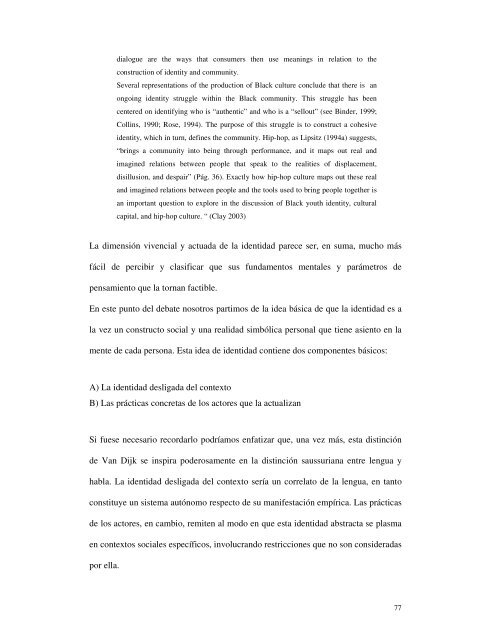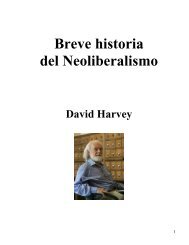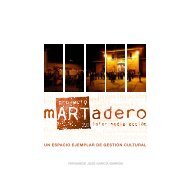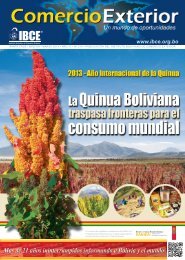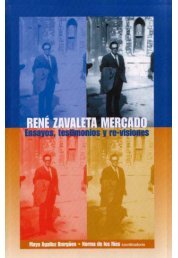You also want an ePaper? Increase the reach of your titles
YUMPU automatically turns print PDFs into web optimized ePapers that Google loves.
dialogue are the ways that consumers then use meanings in re<strong>la</strong>tion to the<br />
construction of identity and community.<br />
Several representations of the production of B<strong>la</strong>ck culture conclude that there is an<br />
ongoing identity struggle within the B<strong>la</strong>ck community. This struggle has been<br />
centered on identifying who is “authentic” and who is a “sellout” (see Binder, 1999;<br />
Collins, 1990; Rose, 1994). The purpose of this struggle is to construct a cohesive<br />
identity, which in turn, defines the community. Hip-hop, as Lipsitz (1994a) suggests,<br />
“brings a community into being through performance, and it maps out real and<br />
imagined re<strong>la</strong>tions between people that speak to the realities of disp<strong>la</strong>cement,<br />
disillusion, and despair” (Pág. 36). Exactly how hip-hop culture maps out these real<br />
and imagined re<strong>la</strong>tions between people and the tools used to bring people together is<br />
an important question to explore in the discussion of B<strong>la</strong>ck youth identity, cultural<br />
capital, and hip-hop culture. “ (C<strong>la</strong>y 2003)<br />
La dimensión vivencial y actuada de <strong>la</strong> identidad parece ser, en suma, mucho más<br />
fácil de percibir y c<strong>la</strong>sificar que sus fundamentos mentales y parámetros de<br />
pensamiento que <strong>la</strong> tornan factible.<br />
En este punto del debate nosotros partimos de <strong>la</strong> idea básica de que <strong>la</strong> identidad es a<br />
<strong>la</strong> vez un constructo social y una realidad simbólica personal que tiene asiento en <strong>la</strong><br />
mente de cada persona. Esta idea de identidad contiene dos componentes básicos:<br />
A) La identidad desligada del contexto<br />
B) Las prácticas concretas de los actores que <strong>la</strong> actualizan<br />
Si fuese necesario recordarlo podríamos enfatizar que, una vez más, esta distinción<br />
de Van Dijk se inspira poderosamente en <strong>la</strong> distinción saussuriana entre lengua y<br />
hab<strong>la</strong>. La identidad desligada del contexto sería un corre<strong>la</strong>to de <strong>la</strong> lengua, en tanto<br />
constituye un sistema autónomo respecto de su manifestación empírica. Las prácticas<br />
de los actores, en cambio, remiten al modo en que esta identidad abstracta se p<strong>la</strong>sma<br />
en contextos sociales específicos, involucrando restricciones que no son consideradas<br />
por el<strong>la</strong>.<br />
77


